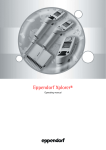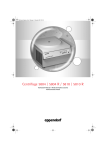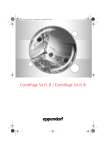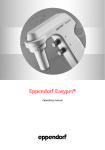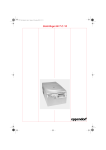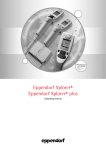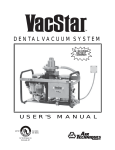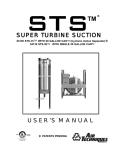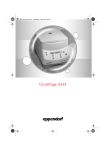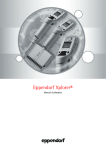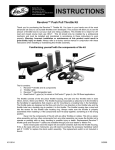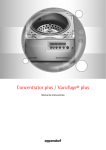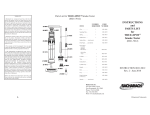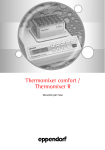Download Research Plus User Manual
Transcript
B 3120 900.012-01/0309 Eppendorf on see Operating p. Tab. Fig. —p. Manual Research® plus Eppendorf Research® plus Operating Manual Eppendorf Research® plus — Operating Manual Copyright© 2008 Eppendorf AG, Hamburg. No part of this publication may be reproduced without the prior permission of the copyright owner. Trademarks eppendorf and Research are registered trademarks of Eppendorf AG, Hamburg, Germany. Registered trademarks are not marked in all cases with ™ or ® in this manual. U.S. Pat. No. 5,531,131 4,961,350 For user adjustment with calibration display, spring to reduce force for tip fitting and for further features patents are pending. Further information can be found on the enclosed CD. Research plus - Operating Manual - en - 01/0309 Eppendorf Research® plus — Operating Manual Table of contents Table of contents 1 Product description . . . . . . . . . . . . . . . . . . . . . . . . . . . . . . . . . . . . . . . . . . . . . . . . . . . . . . 4 2 Error search . . . . . . . . . . . . . . . . . . . . . . . . . . . . . . . . . . . . . . . . . . . . . . . . . . . . . . . . 11 Maintenance . . . . . . . . . . . . . . . . . . . . . . . . . . . . . . . . . . . . . . . . . . . . . . . . . . . . . . . . . . . 12 5.1 5.2 5.3 5.4 5.5 5.6 6 Setting the volume (adjustable-volume pipettes Research plus only) . . . . . . . . . . . . . 9 Attaching pipette tips . . . . . . . . . . . . . . . . . . . . . . . . . . . . . . . . . . . . . . . . . . . . . . . . . . 9 Aspirating liquid . . . . . . . . . . . . . . . . . . . . . . . . . . . . . . . . . . . . . . . . . . . . . . . . . . . . . 10 Dispensing liquids . . . . . . . . . . . . . . . . . . . . . . . . . . . . . . . . . . . . . . . . . . . . . . . . . . . 10 Troubleshooting . . . . . . . . . . . . . . . . . . . . . . . . . . . . . . . . . . . . . . . . . . . . . . . . . . . . . . . . 11 4.1 5 Warning signs and hazard icons . . . . . . . . . . . . . . . . . . . . . . . . . . . . . . . . . . . . . . . . . 7 Intended use. . . . . . . . . . . . . . . . . . . . . . . . . . . . . . . . . . . . . . . . . . . . . . . . . . . . . . . . . 7 Hazards arising from the intended use. . . . . . . . . . . . . . . . . . . . . . . . . . . . . . . . . . . . . 7 Operation . . . . . . . . . . . . . . . . . . . . . . . . . . . . . . . . . . . . . . . . . . . . . . . . . . . . . . . . . . . . . . . 9 3.1 3.2 3.3 3.4 4 4 4 5 5 6 Safety . . . . . . . . . . . . . . . . . . . . . . . . . . . . . . . . . . . . . . . . . . . . . . . . . . . . . . . . . . . . . . . . . . 7 2.1 2.2 2.3 3 Features . . . . . . . . . . . . . . . . . . . . . . . . . . . . . . . . . . . . . . . . . . . . . . . . . . . . . . . . . . . . Delivery package . . . . . . . . . . . . . . . . . . . . . . . . . . . . . . . . . . . . . . . . . . . . . . . . . . . . . Full illustration. . . . . . . . . . . . . . . . . . . . . . . . . . . . . . . . . . . . . . . . . . . . . . . . . . . . . . . . 1.3.1 Research plus single-channel. . . . . . . . . . . . . . . . . . . . . . . . . . . . . . . . . . . . . . 1.3.2 Research plus multi-channel. . . . . . . . . . . . . . . . . . . . . . . . . . . . . . . . . . . . . . . Table of contents 1.1 1.2 1.3 Cleaning . . . . . . . . . . . . . . . . . . . . . . . . . . . . . . . . . . . . . . . . . . . . . . . . . . . . . . . . . . . Sterilizing or disinfecting the pipette . . . . . . . . . . . . . . . . . . . . . . . . . . . . . . . . . . . . . . 5.2.1 Autoclaving . . . . . . . . . . . . . . . . . . . . . . . . . . . . . . . . . . . . . . . . . . . . . . . . . . . 5.2.5 Disinfecting . . . . . . . . . . . . . . . . . . . . . . . . . . . . . . . . . . . . . . . . . . . . . . . . . . . Replacing O-rings. . . . . . . . . . . . . . . . . . . . . . . . . . . . . . . . . . . . . . . . . . . . . . . . . . . . 5.3.1 Remove O-ring . . . . . . . . . . . . . . . . . . . . . . . . . . . . . . . . . . . . . . . . . . . . . . . . 5.3.2 Mounting a new O-ring . . . . . . . . . . . . . . . . . . . . . . . . . . . . . . . . . . . . . . . . . . Research plus disassembly and assembly . . . . . . . . . . . . . . . . . . . . . . . . . . . . . . . . 5.4.1 Single-channel up to 1,000 μL (adjustable and fixed-volume) . . . . . . . . . . . . 5.4.2 Single-channel 5 mL and 10 mL . . . . . . . . . . . . . . . . . . . . . . . . . . . . . . . . . . . 5.4.3 Multi-channel . . . . . . . . . . . . . . . . . . . . . . . . . . . . . . . . . . . . . . . . . . . . . . . . . Calibrating pipettes. . . . . . . . . . . . . . . . . . . . . . . . . . . . . . . . . . . . . . . . . . . . . . . . . . . 5.5.1 General notes . . . . . . . . . . . . . . . . . . . . . . . . . . . . . . . . . . . . . . . . . . . . . . . . . 5.5.2 Procedure . . . . . . . . . . . . . . . . . . . . . . . . . . . . . . . . . . . . . . . . . . . . . . . . . . . . Decontamination before shipment . . . . . . . . . . . . . . . . . . . . . . . . . . . . . . . . . . . . . . . 12 12 12 13 14 14 14 15 15 17 18 20 20 21 22 Technical data . . . . . . . . . . . . . . . . . . . . . . . . . . . . . . . . . . . . . . . . . . . . . . . . . . . . . . . . . . 23 6.1 6.2 6.3 6.4 Research plus single-channel adjustable-volume . . . . . . . . . . . . . . . . . . . . . . . . . . . Research plus multi-channel adjustable volume . . . . . . . . . . . . . . . . . . . . . . . . . . . . Research plus fixed-volume . . . . . . . . . . . . . . . . . . . . . . . . . . . . . . . . . . . . . . . . . . . . Ambient conditions . . . . . . . . . . . . . . . . . . . . . . . . . . . . . . . . . . . . . . . . . . . . . . . . . . . 23 24 24 25 3 Eppendorf Research® plus — Operating Manual 1 Product description 1 Product description Operating Manual 1.1 Features The Research plus pipettes are piston-stroke pipettes which function according to the air-cushion principle. When the control button is pressed, the piston in the pipette moves in the same direction. If the control button and the piston are moved upwards, the liquid can be aspirated into the pipette tip. With the downward movement of the piston, the liquid is dispensed (measuring stroke). Blow-out occurs if the downward piston stroke exceeds the first stop. Depending on the Research plus pipette it is possible to dispense volumes from 0.1 μL to 10 mL. The Research plus family consists of single-channel and multi-channel pipettes (8 and 12 channels) with variable volume settings, as well as single-channel fixed-volume pipettes. You can find a list of all available models of the Research plus in the Technical Data section. All Research plus pipettes are fully autoclavable. You can calibrate the Research plus pipettes. The side viewing window displays the change in the calibration. When attaching a pipette tip, the spring-loading action of the tip cone is activated (exceptions: 5 mL and 10 mL pipettes). Product description 1 1.2 Delivery package The Research plus delivery package contains: Pcs. Description 1 Research plus operating manual 1 Certificate 1 Adjustment tool (allen key with blue handle) 1 Mini CD 1 Black locking ring for single-channel pipettes ≤ 1,000 μL 5 Red calibration seal 5 Protective filters for 5 mL and 10 mL pipettes 1 Tool for opening the lower part (5 mL and 10 mL) 1 Tool for cutting the O-rings (multi-channel 100 μL and 300 μL only) Sample epT.I.P.S. or box (exception: fixed-volume pipettes) 4 Eppendorf Research® plus — Operating Manual 1 Product description 1.3 1.3.1 Full illustration Research plus single-channel 1 2 4 5 6 7 8 1 2 Volume adjustment To set the volume for adjustable-volume pipettes. Product description 3 1 Control button The control button and the trays of the matching epT.I.P.S. pipette tips are the same color. 3 Ejector Moves the ejector sleeve and ejects the pipette tip. 4 Volume display (adjustable-volume pipettes only) Read the set volume from top to bottom. 5 Adjustment opening The adjustment opening is covered by the silver calibration seal when the pipette is delivered. 6 Calibration display Set to "0" when pipettes are delivered. 7 Labeling area Space for adhesive label with internal lab data. The serial number is located at the bottom. 9 10 8 Ejector sleeve Discard the pipette tips after use. 9 Spring-loaded tip cone Spring loading optimizes the force for taking up and ejecting the tip (not spring-loaded for 5 mL and 10 mL pipettes). The tip cone of the 5 mL and 10 mL pipettes contains an easily exchangeable protection filter. 10 Pipette tip The Research plus pipettes can only be used with matching pipette tips. We recommend the use of epT.I.P.S. 5 Eppendorf Research® plus — Operating Manual 1 Product description 1.3.2 Research plus multi-channel For an explanation of the pipette upper part, please refer to the full illustration of the single-channel pipette (see p. 5). 1 Product description 1 Lever To release the lower part of the multi-channel pipette. 6 1 2 3 4 2 Multi-channel lower part The multi-channel lower part can be rotated freely. The lower part is not released when it is rotated. The outer channels are marked with the numbers 1 and 8 (and/or 12). The multi-channel version has a piston for each channel so that it can be fitted with less than 8 and/or 12 tips. The lower part can be exchanged from an 8-channel to a 12-channel version with an identical volume range. The multi-channel lower part can be opened so that individual channels can be replaced or removed. 3 Latches right and left Releases the cover plate with interior ejector rail. 4 Spring-loaded tip cones Spring loading optimizes the force for taking up and ejecting the tip. 5 Pipette tips We recommend the use of epT.I.P.S. 5 6 6 Cover plate Removable cover plate with interior ejector rail. Eppendorf Research® plus — Operating Manual 2 Safety 2 Safety Operating Manual 2.1 Warning signs and hazard icons Depiction Meaning WARNING Warning of potential injury. CAUTION 2.2 Notification of lower risk or danger of material damage. 2 Intended use 2.3 Safety The Research plus is a lab device intended for dispensing liquids in the volume range from 0,1 μL to 10 mL, in combination with matching pipette tips. In vivo applications (applications in or on the human body) are not permitted. The Research plus may only be operated by trained specialist staff. All users must have read the operating manual carefully and familiarized themselves with the device's mode of operation. Hazards arising from the intended use Warning! Poor safety due to incorrect accessories and spare parts. WARNING! The use of accessories and spare parts other than those recommended by Eppendorf may impair the security, function and precision of the device. Eppendorf accepts no warranty or liability for damage caused by third-party parts or incorrect use. Use only original accessories recommended by Eppendorf. WARNING! WARNING! CAUTION! Warning! Damage to health from toxic, radioactive or aggressive chemicals, as well as infectious or pathogenic samples. Follow national regulations governing the handling of these substances. Wear personal protective equipment (PPE) at all times when working with hazardous biological or chemical substances and use protective equipment. Warning! Danger to persons from careless use. Never point the tip cone of a Research plus equipped with a pipette tip at yourself or anyone else. Only initiate dispensing if it is safe to do so. With all dispensing tasks, make sure that you are not endangering yourself or anyone else. Caution! Damage to the device from missing pipette tips or penetration of liquid. Use the Research plus with fitted pipette tips only. When using standard tips (without filter): use the 1 - 10 mL and 0.5 - 5 mL pipettes only with the prorection filter inserted. Do not put the pipette down if the tip still contains liquid. 7 Eppendorf Research® plus — Operating Manual 2 Safety CAUTION! Safety 2 CAUTION! 8 Caution! Material damage and dispensing errors caused by faulty use or cleaning. Use the pipette tips only once. Do not clean the pipette with acetone or aggressive solutions. Do not use use any sharp-edged objects for cleaning. epT.I.P.S. are made of PP, epDualfilter T.I.P.S. are made of PP and filters are made of PE. Do not use the pipette and pipette tips with liquids which corrode these materials. The parts of the Research plus which might come into contact with liquid if handled or cleaned incorrectly are made of PP, PEI, PVDF, PC, PPS, silicone, stainless steel. Do not autoclave the epDualfilter T.I.P.S. If filter tips are used: use the 1 – 10 mL and 0.5 – 5 mL pipettes without protection filters. The protection filter and the filter in the tip can interfere with each other, which can lead to tip leakage. Caution! Lack of safety due to missing operating manual. When passing on the device, always enclose the operating manual. If you lose the operating manual, request a replacement. You can also find the current version of the operating manual on our website www.eppendorf.com. Eppendorf Research® plus — Operating Manual 3 Operation 3 Operation Operating Manual 3.1 Setting the volume (adjustable-volume pipettes Research plus only) To change the volume, turn the volume setting as shown. The height of the control button changes as the volume is adjusted. The numbers on the volume display are to be read from the top to the bottom. The decimal places are below the hyphen. Up to 1,000 μL, the volume is displayed in μL. For the 5 mL and 10 mL sizes, the volume is displayed in mL. We recommend to adjust the volume setting from a higher value to a lower value. If required, turn beyond the required value and then back again. 3 3.2 Attaching pipette tips Operation The pipette is only functional if a pipette tip has been mounted. If you are using pipette tips without filters, insert the protective filters into the 5 mL and 10 mL pipettes. If you are using the 5 mL or 10 mL epDualfilter T.I.P.S., remove the protective filter from the pipette first. This also applies to 5 mL/10 mL filter tips of other manufacturers. The filters can interfere with each other. The backpressure of the two filters makes it difficult to exactly identify the first stop (see p. 10). Fit suitable pipette tip(s) on the tip cone, applying light pressure. The pipette tip sits firmly on the tip cone when it responds with spring-loaded action (exception: no spring-loading action for 5 mL and 10 mL pipettes). You can deactivate the spring loading of the tip cone when using single-channel pipettes (see p. 15). 9 Eppendorf Research® plus — Operating Manual 3 Operation 3.3 Aspirating liquid 3 Operation 3.4 10 1. Provide the liquid in a suitable tube. For multi-channel pipettes we recommend the reagent reservoir "Tip-Tub". 2. Press the control button until the first stop (measuring stroke). 3. Immerse pipette tip(s) vertically 4 mm into the liquid. 4. For liquid aspiration, let the control button slide back slowly. Maintain the immersion depth, so that no air is aspirated accidentally. 5. For large volumes: Wait for 3 seconds before pulling the pipette out of the liquid. For highest precision and trueness we recommend wetting each new tip first by aspiring and dispensing the liquid one to three times. Only then should pipetting commence. 6. Remove the tip(s) slowly from the liquid. 7. Wipe the tip(s) carefully against the tube wall to ensure that there is no outer wetting on the tip(s). 1. Apply tip(s) to the tube wall at an angle. 2. Press the control button slowly until the first stop (measuring stroke) and wait until the flow of liquid stops. 3. To empty the tip(s) completely, press the control button until the second stop (blow-out). 4. Hold control button and wipe the tip(s) against the inner tube wall. 5. Let the control button slide back slowly outside of the tube. 6. To eject the tips, press the ejector. Pipette tips are for single use only. Dispensing liquids Eppendorf Research® plus — Operating Manual 4 Troubleshooting 4 Troubleshooting Operating Manual 4.1 Error search Observation Liquid is dripping from the tip and/or dispensed volume is incorrect. Calibration seal removed; calibration display changed. No spring-loading action of the tip cone when taking up pipette tips. • Pipette has been Calibrate pipette for the liquid used • Remove locking ring again. • calibrated for another liquid. Spring-loading action is blocked by locking ring. You are using a 5 mL or 10 mL pipette. 4 Troubleshooting Control button jams, runs jerkily. Possible cause Error correction • Pipette tip is loose or does Attach tip firmly; use epT.I.P.S. If not fit correctly. using 5 mL and 10 mL epDualfilter T.I.P.S., do not use protection filters in the pipette. • Liquid with high vapor Wet tip several times and calibrate pressure and/or different pipette for the liquid used. density. • Pipetted too quickly. Move control button slowly. • Tip withdrawn from the Withdraw tip from the liquid slowly liquid too quickly. and with a time-delay of about 3 seconds. • Liquid aspirated with Repeat procedure and dispense blow-out or dispensed with correctly. blow-out. • Piston soiled or damaged. Clean piston, relubricate slightly and/ or replace. • Tip cone damaged. Replace lower part or channel. • O-rings of the tip cones Replace O-rings (100 μL, 300 μL are damaged. multi-channel only). • Piston soiled. Clean lower part. • Seal soiled. 5 mL and 10 mL sizes: replace protection filter. • Pipette blocked. (see Procedure on p. 21). No remedy available. The tip cones of these sizes do not have spring-loading action. Regularly check precision and trueness of the Research plus to avoid dispensing errors. You can use the "PICASO" software (from version 2.3) for determining the maximum permissible systematic and random error. If the pipette is used at an extremely high location, it must be calibrated to the ambient air pressure. You can find an SOP (Standard Operation Procedure) for the test on our website www.eppendorf.com. 11 Eppendorf Research® plus — Operating Manual 5 Maintenance 5 5 Maintenance Operating Manual Maintenance CAUTION! Caution! Irreversible damage due to aggressive liquids. Viewing windows, surfaces and print will be damaged if aggressive liquids are used. The parts of the pipette which might come into contact with liquid are made of the following materials: PP, PEI, PVDF, PC, PPS, silicone and stainless steel. Further information can be found on the enclosed CD. Pay attention to the materials of the pipette and accessories. Do not clean the pipette with acetone or other aggressive liquids. Do not allow any liquids to penetrate the upper part of the pipette. • All single- and multichannel lower parts are wear parts. Clean them after contamination, use • of aggressive chemicals and/or heavy stress. If the lower parts are worn or damaged, replace the respective parts. Faulty dispensing results are sometimes due to lack of maintenance. 5.1 Cleaning Remove contaminations on the outside of the Research plus as follows: Wet a cloth with a mild cleaning fluid and water and remove the contamination. CAUTION! Caution! Damage from sharp objects. The cylinder can get damaged from sharp objects. Do not use sharp objects for cleaning. To remove heavy contamination resulting from ingress of fluids, disassemble the lower part of the pipette (see Research plus disassembly and assembly on p. 15). Use demin. water for cleaning. Relubricate the piston sealing rings after contamination, use of aggressive chemicals and/or heavy stress. Remove the old grease before relubricating. Use only the grease specified in the ordering information (see enclosed CD). 5.2 CAUTION! 5.2.1 Sterilizing or disinfecting the pipette Caution! Irreversible damage from incorrect treatment. Do not use any additional disinfectants, decontamination agents or sodium hypochlorite during autoclaving or UV exposure. When autoclaving make sure that the temperature does not exceed 121 °C. Before using disinfecting agents or decontaminating agents, test for material compatibility and check the manufacturer's instructions about chemical resistance. Also, pay attention to the materials of the pipette. Autoclaving All Research plus pipettes are fully steam autoclavable. 12 Eppendorf Research® plus — Operating Manual 5 Maintenance 5.2.2 5 Before autoclaving 5.2.3 Maintenance 1. Remove any contamination from the inside and outside of the lower part (see Research plus disassembly and assembly on p. 15). 2. If you remove any grease, only use the grease specified in the ordering information (see enclosed CD) for slightly relubricating the piston sealing ring. Execution Follow the operating manual of the autoclave manufacturer. 1. Autoclave at: 121 °C; 20 minutes; 1 bar overpressure 2. When placing the Research plus into the autoclave, make sure that the temperature at the pipette does not exceed 121 °C. 3. You can put the Research plus into the autoclave as a whole unit or with the lower part removed. Do not disassemble the lower part. 4. 5 mL and 10 mL pipettes: Remove old protection filter. Have the new protection filter available and insert it after autoclaving. Autoclave the protection filter only once. 5. If the lower parts have been removed, make sure that no lower parts are confused during reassembly. (Tip: Use one plastic beaker per pipette.) 5.2.4 After autoclaving Cool pipette down to room temperature and leave to dry. 5 mL/10 mL pipettes: The protection filter swells during autoclaving. Slightly compress the protection filter when inserting it into the tip cone. The piston does not need to be relubricated after autoclaving. If autoclaving is carried out as described above, no gravimetric testing or calibration is necessary. 5.2.5 Disinfecting Wipe off the outer surfaces with disinfectant, DNA/RNA decontamination agent or 70 % isopropanol. Alternatively wipe the outside of the tip cone and ejector sleeve with 4 % sodium hypochlorite solution and leave on for a while. After the exposure time of the sodium hypochlorite solution has elapsed, remove thoroughly with demineralized water. The Research plus pipettes may be temporarily subjected to the UV light of a sterile bench ( ≥254 nm). 13 Eppendorf Research® plus — Operating Manual 5 Maintenance 5 5.3 Replacing O-rings Maintenance The multi-channel lower parts 100 μL and 300 μL are equipped with O-rings. These are wear parts. Replace old, worn or damaged O-rings. Defective O-rings result in incorrect positioning of the tips and in dispensing errors. 5.3.1 Remove O-ring 1. Push the opening of the tool (delivery package) against the tip cone from below, so that the sharp edge in the opening of the tool and the O-ring are positioned on top of one another. Do not slide the tool onto the cone! 2. Supporting the tool with your thumb, push it firmly against the tip cone from below. The O-ring is cut in one place. 3. Remove the tool and the O-ring from the tip cone. 5.3.2 Mounting a new O-ring 1. Fit the mounting aid (shortened pipette tip) on the tip cone. 2. Push the new O-ring over the tip onto to the tip cone. 3. Check that the pipette is functioning. 14 Eppendorf Research® plus — Operating Manual 5 Maintenance 5.4 5.4.1 5 Research plus disassembly and assembly Single-channel up to 1,000 μL (adjustable and fixed-volume) Maintenance Removing the lower part PUSH UP TO RELEASE 1 1. 2. 2 3 4 : Keep the ejector pressed and pull off the ejector sleeve. and 3 : On the lower part, slide the ring marked "PUSH UP TO RELEASE" up by about 5 mm until the lower part comes off. 3. 4 : Take the lower part out of the upper part. 1 2 Deactivating the spring-loading action: installing the locking ring For dispensing tasks in which • a pipette tip is used over a long time or • the pipette tip is slightly bended, it can be helpful to deactivate the spring loading of the tip cone. This can also be helpful for pipette tips which are not designed for the Eppendorf pipette tip cone. The spring loading of the tip cone can be deactivated by installing the locking ring. The locking ring is included in the delivery package. 1. 2. 3. 4. Push the black locking ring onto the lower part from the top. Insert the lower part into the upper part until it engages audibly. Keep the ejector pressed. The ejector rod protrudes from the upper part. Fit the ejector sleeve onto the ejector rod. It is fitted correctly if it engages slightly. Remove the locking ring to reactivate the spring-loading action. 15 Eppendorf Research® plus — Operating Manual 5 Maintenance 5 Opening and assembling the lower part (≤1,000 μL) Maintenance 1 2 3 4 To avoid confusion of parts, only disassemble and assemble one pipette at a time. Opening the lower part: 1. On the piston mount (1) push the stop pins together slightly. 2. Remove the piston mount. 3. Remove piston (2) and piston spring (3). The piston is under spring tension. Pistons and piston springs will look different for the individual volume versions. Assembling the lower part: 1. Guide piston and piston spring into the cylinder. Make sure that the piston is guided correctly in the cylinder and in the piston spring. There must not be any perceptible resistance. In the case of piston springs with double windings (4), these windings must point downwards. 2. Keep piston and piston spring pressed. 3. Keep the stop pins on the piston mount pressed with the other hand. 4. Mount the piston mount in such a way that the two stop pins engage in their retainers. Installing the lower part and ejector sleeve: 1. Insert the lower part into the upper part until it engages audibly. 2. Set the maximum volume and operate the control button several times. It must run smoothly and resistance-free. 3. Keep the ejector pressed. The ejector rod protrudes from the upper part. 4. Fit the ejector sleeve onto the ejector rod. It is fitted correctly if it engages slightly. 5. Carry out a gravimetric test of the systematic and random error (see Technical data on p. 23). This test ensures that no parts were confused during assembly and that the pipette has been assembled correctly. 16 Eppendorf Research® plus — Operating Manual 5 Maintenance 5.4.2 5 Single-channel 5 mL and 10 mL Replace the protection filter in the tip cone after each contact with liquid or if it is frayed. Maintenance 4 1 30° 2 1 1. 2. 2 3 : Unscrew the ejector sleeve. : Keep the ejector pressed and turn the lower part to the left or right by approximately 30°. The lower part is automatically released from the upper part. 3. 3 : Opening the lower part: Position the key 4 (delivery package) on the lower part. Hold the cylinder and unscrew it from the lower part. For the next steps, please refer to the figure on the next page. 1 2 17 Eppendorf Research® plus — Operating Manual 5 Maintenance 5 Maintenance 4. Hold the piston (4) which is now partly visible in the lower part. 5. Push the piston mount (1) slightly downwards (3 mm) and turn it by 45°. The piston spring pushes the piston mount upwards. The lower part opens. The lower part consists of the following: 1 2 3 4 5 1 Piston mount 5 mL / 10 mL 2 Piston spring 3 Upper part of the lower part 4 Piston (with seal) 5 Cylinder and tip cone 6 Protection filter in the tip cone 6 Before assembling the pipette install the piston mount, the piston spring, and the piston in the upper part of the lower part first. Further assembly is as shown in the figures. Carry out the procedure in reverse order. After the assembly: Carry out a gravimetric test of the systematic and random error (see Technical data on p. 23). This test ensures that no parts were confused during assembly and that the pipette has been assembled correctly. 5.4.3 Multi-channel Loosening and opening the multi-channel lower part 1 1. 2 1 and 2 : Slide the lever on the lower part to the left or right. This separates the lower part from the upper part so that it can be removed. 2. Put down the lower part with the lever facing downwards. 3. 3 : Slide the two latches down. Use a coin to do this. The lower part is still lying with the lever facing downwards. 4. Take off the cover panel with integrated ejector rail. Do not remove the ejector rail from the cover panel. The spring for the ejector rail could accidentally come off and get lost. 18 3 Eppendorf Research® plus — Operating Manual 5 Maintenance 5 Removing and installing channels 1 1. 2. 3. 4. 5. 6. 2 3 4 Maintenance Channels must only be removed and installed if the multi-channel lower part is separated from the upper part! The channels in the lower parts consist of piston, cylinder and spring. The channels for 100 μL and 300 μL are equipped with an O-ring at the tip cone (see Replacing O-rings on p. 14). 5 1 and 2 : Position a pipette tip under the piston and carefully take the piston off the upper rail. Carefully pull the piston out in an upward direction. Do not bend the piston. Take the tip cone at the lower end and push it slightly upwards 3 . This compresses the spring. 4 : Lift the tip cone slightly and release it from the lower rail. 5 : Relax the spring by letting the tip cone slide back again above the lower rail. 5 : Take the tip cone with the cylinder and the spring out of the upper rail. Before installation, slide the piston into the cylinder. Install the channels in reverse order. Assembling the multi-channel pipette 1. 2. 3. 4. Fit the cover plate with integrated ejector. Push the latches upwards. To mount, push the lower part into the upper part until it engages audibly. Carry out a gravimetric test of the systematic and random error (see Technical data on p. 23). This test ensures that no parts were confused during assembly and that the pipette has been assembled correctly. 19 Eppendorf Research® plus — Operating Manual 5 Maintenance 5 5.5 Maintenance CAUTION! Calibrating pipettes Caution! Incorrect dispensing volume for special liquids and from temperature differences. Solutions whose physical data deviate significantly from those of water and differences in temperature between pipettes, pipette tips and liquids can result in inaccurate dispensing volumes. Check the dispensing volume. Avoid differences in temperature. 5.5.1 General notes The Research plus was calibrated, tested und fitted with a silver calibration seal before delivery. The calibration display on the side reads "0". A calibration of the Research plus is only required for solutions which are very different from water with regard to their density, viscosity, surface tension and/or vapor pressure. If the density of an aqueous solution changes by approximately ±10 %, for example because of the salt concentration, the volume changes by approximately ±0.2 %. This statement does not apply if other relevant properties of the liquid also change. If the pipette is used at extremely high altitudes, it must be calibrated to the ambient air pressure. At 1,000 m above sea level the volume error is about –0.4 %. The actual volume can be checked by weighing: If the set volume corresponds to the actual volume, no correction is necessary. The density of distilled water is approx. 0.9982 mg/μL at 20 °C. If there is a difference between the actual volume and the set volume, please check the following: • Is no liquid dripping from the tip? • Is the pipette tip fitted leak-proof? • Is the tip cone undamaged? • Are piston and cylinder leak-proof? • Does the temperature of the pipetted liquid correspond to: – the temperature of the device? – the ambient air temperature? • Is the weighing location free from drafts? • Does the work method and pipetting speed permit complete aspiration and dispensing of the liquid? • Has the correct numerical value for "Density of the liquid at weighing temperature" been used for the calculation of the actual volume? • Is the set volume correct? • For very small volumes (<10 μL): Is the fine balance sufficiently sensitive (balance resolution: 0.001 mg)? 20 Eppendorf Research® plus — Operating Manual 5 Maintenance 5 • Were original epT.I.P.S pipette tips used for testing? Information as to which pipette tip must 5.5.2 Maintenance be used as a test tip for checking the technical data can be found in the Technical Data chapter of the operating manual. Only if you can answer all the questions with yes, may the calibration be changed. Procedure If the calibration is changed, the volume changes by a certain value. Strictly speaking, this change only applies to the testing volume. Example: You recalibrate a 10 - 100 μL pipette with a volume setting of 100 μL by 1 μL (1 μL 1 %). If the volume setting is 10 μL, the pipette is also adjusted by 1 μL ( 10 %). 1. Remove the silver calibration seal. 2. Keep the ejector pressed. 3. Insert the adjustment tool (from the delivery package). 4. Turn the adjustment tool until the desired value is displayed on the calibration display. 5. Carry out weighings to verify trueness and precision. 6. After the checks, stick the red calibration seal (from the delivery package) on. If the calibration is meant for a specific liquid, mark the pipette accordingly. Use the labeling area on the pipette for this purpose and write down the liquid and the volume. Check any changes to the calibration gravimetrically. Please note the test procedures of EN ISO 8655-2 and 8655-6. An SOP (Standard Operation Procedure) can be found on our website www.eppendorf.com. 21 Eppendorf Research® plus — Operating Manual 5 Maintenance 5 5.6 Decontamination before shipment Maintenance If you wish to return the pipette to Eppendorf AG or an Eppendorf AG service partner for checking or repair, please note the following. Caution! Risk to health from contaminated pipette. WARNING! 1. Perform decontamination before returning or storing the pipette. 2. The pipette must be clean and free of hazardous substances. Hazardous substances are: • solutions presenting a hazard to health • potentially infectious agents • organic solvents and reagents • radioactive substances • proteins presenting a hazard to health • DNA 1. Please note the information in the document "Decontamination certificate for product returns". You can find it as a PDF file on our homepage www.eppendorf.com. 2. Enter the serial number of the Research plus into the decontamination certificate. This can be found at the lower end of the entry field. 3. Please include with the shipment the completed and signed "Decontamination certificate for product returns" for each pipette. 22 Eppendorf Research® plus — Operating Manual 6 Technical data 6 Technical data Operating Manual 6.1 Research plus single-channel adjustable-volume Model / Step size epT.I.P.S. Color code Volume Error volume range Volume range Systematic Random Length ±% ± μL ±% ± μL 0.002 μL dark gray 0.1 – 10 μL 34 mm 0.1 μl 0.25 μL 1.25 μL 2.5 μL ± 48 ± 12 ± 2.5 ± 1.4 ± 0.048 ± 0.03 ± 0.031 ± 0.035 ± 12 ±6 ± 1.5 ± 0.7 ± 0.012 ± 0.015 ± 0.019 ± 0.018 0.5 – 10 μL 0.01 μL medium gray 0.1 – 20 μL 40 mm 0.5 μl 1 μL 5 μL 10 μL ±8 ± 2.5 ± 1.5 ± 1.0 ± 0.04 ± 0.025 ± 0.075 ± 0.1 ±5 ± 1.8 ± 0.8 ± 0.4 ± 0.025 ± 0.018 ± 0.04 ± 0.04 2 – 20 μL 0.02 μL light gray 0.5 – 20 μL 46 mm 2 μL 10 μL 20 μL ±5 ± 1.2 ± 1.0 ± 0.1 ± 0.12 ± 0.2 ± 1.5 ± 0.6 ± 0.3 ± 0.03 ± 0.06 ± 0.06 2 – 20 μL 0.02 μL yellow 2 – 200 μL 53 mm 2 μL 10 μL 20 μL ±5 ± 1.2 ± 1.0 ± 0.1 ± 0.12 ± 0.2 ± 1.5 ± 0.6 ± 0.3 ± 0.03 ± 0.06 ± 0.06 10 – 100 μL 0.1 μL yellow 2 – 200 μL 53 mm 10 μL 50 μL 100 μL ±3 ±1 ± 0.8 ± 0.3 ± 0.5 ± 0.8 ±1 ± 0.3 ± 0.2 ± 0.1 ± 0.15 ± 0.2 20 – 200 μL 0.2 μL yellow 2 – 200 μL 53 mm 20 μL 100 μL 200 μL ± 2.5 ±1 ± 0.6 ± 0.5 ±1 ± 1.2 ± 0.7 ± 0.3 ± 0.2 ± 0.14 ± 0.3 ± 0.4 30 – 300 μL 0.2 μL orange 20 – 300 μL 55 mm 30 μL 150 μL 300 μL ± 2.5 ±1 ± 0.6 ± 0.75 ± 1.5 ± 1.8 ± 0.7 ± 0.3 ± 0.2 ± 0.21 ± 0.45 ± 0.6 100 – 1,000 μL 1 μL blue 50 – 1,000 μL 71 mm 100 μL ±3 500 μL ±1 1,000 μL ± 0.6 ±3 ±5 ±6 ± 0.6 ± 0.2 ± 0.2 ± 0.6 ± 1.0 ± 2.0 0.5 – 5 mL 0.005 mL purple 0.1 – 5 mL 120 mm 0.5 mL 2.5 mL 5 mL ± 2.4 ± 1.2 ± 0.6 ± 12 ± 30 ± 30 ± 0.6 ± 0.25 ± 0.15 ± 3.0 ± 6.0 ± 8.0 1 – 10 mL 0.01 mL turquoise 1 – 10 mL 165 mm 1 mL 5 mL 10 mL ±3 ± 0.8 ± 0.6 ± 30 ± 40 ± 60 ± 0.6 ± 0.2 ± 0.15 ± 6.0 ± 10.0 ± 15.0 Technical data 0.1 – 2.5 μL 6 23 Eppendorf Research® plus — Operating Manual 6 Technical data 6.2 Research plus multi-channel adjustable volume Model 8 or Step size Color code epT.I.P.S. Volume 12 channels Volume range / volume Length range Technical data 6 Systematic ±% ± μL Error Random ±% ± μL 0.5 – 10 μL 0.01 μL medium gray 0.1 – 20 μL 40 mm 0.5 μL 1 μL 5 μL 10 μL ± 12 ± 8.0 ± 4.0 ± 2.0 ± 0.06 ± 0.08 ± 0.2 ± 0.2 ± 8.0 ± 5.0 ± 2.0 ± 1.0 ± 0.04 ± 0.05 ± 0.1 ± 0.1 10 – 100 μL 0.1 μL yellow 2 – 200 μL 53 mm 10 μL 50 μL 100 μL ± 3.0 ± 1.0 ± 0.8 ± 0.3 ± 0.5 ± 0.8 ± 2.0 ± 0.8 ± 0.3 ± 0.2 ± 0.4 ± 0.3 30 – 300 μL 0.2 μL orange 20 – 300 μL 55 mm 30 μL 150 μL 300 μL ± 3.0 ± 1.0 ± 0.6 ± 0.9 ± 1.5 ± 1.8 ± 1.0 ± 0.5 ± 0.3 ± 0.3 ± 0.75 ± 0.9 6.3 Research plus fixed-volume Model / volume epT.I.P.S. color code Volume range Error Random ±% 10 μL medium gray, 0.1 – 20 μL ± μL ± 0.6 ± 0.06 20 μL light gray, 0.5 – 20 μL L ± 0.8 10 μL yellow, 2 – 200 μL ± 1.2 ± 0.16 ± 0.3 ± 0.06 ± 0.12 ± 0.6 ± 0.06 20 μL yellow, 2 – 200 μL ± 1.0 ± 0.2 ± 0.3 ± 0.06 25 μL yellow, 2 – 200 μL ± 1.0 ± 0.25 ± 0.3 ± 0.08 50 μL yellow, 2 – 200 μL ± 0.7 ± 0.35 ± 0.3 ± 0.15 100 μL yellow, 2 – 200 μL ± 0.6 ± 0.6 ± 0.2 ± 0.2 200 μL yellow, 2 – 200 μL ± 0.6 ± 1.2 ± 0.2 ± 0.4 200 μL blue, 50 – 1,000 μL ± 0.6 ± 1.2 ± 0.2 ± 0.4 250 μL blue, 50 – 1,000 μL ± 0.6 ± 1.5 ± 0.2 ± 0.5 500 μL blue, 50 – 1,000 μL ± 0.6 ±3 ± 0.2 ±1 1,000 μL blue, 50 – 1,000 μL ± 0.6 ±6 ± 0.2 ±2 Systematic ±% ± μL ± 1.2 ± 0.12 Test conditions according to ISO 8655-1, 8655-2 and 8655-6 for piston-stroke pipettes with air cushion by means of a metrologically tested fine balance with evaporation protection. Number of determinations: 10; water according to ISO 3696; 20 °C to 25 °C ±0.5 °C constant; with pre-wetted pipette tip; dispensing against the tube wall. 24 Eppendorf Research® plus — Operating Manual 6 Technical data 6.4 Ambient conditions Temperature range Relative humidity Storage without transport packaging –5 to 45 °C 10 to 95% Operating conditions 5 to 40 °C 10 to 95% 6 Technical data Technical specifications subject to change. Note: Ordering information can be found on the enclosed CD. 25 Eppendorf Research® plus — Operating Manual 6 Technical data Technical data 6 26 Eppendorf offices Eppendorf offices AUSTRALIA & NEW ZEALAND Eppendorf South Pacific Pty. Ltd. Phone: +61 2 9889 5000 Fax: +61 2 9889 5111 E-mail: [email protected] Internet: www.eppendorf.com.au CANADA Eppendorf Canada Ltd. Phone: +1 905 826 5525 Fax: +1 905 826 5424 E-mail: [email protected] Internet: www.eppendorfna.com FRANCE Eppendorf France S.A.R.L. Phone: +33 1 30 15 67 40 Fax: +33 1 30 15 67 45 E-mail: [email protected] Internet: www.eppendorf.fr ITALY Eppendorf s.r.l. Phone: +390 2 55 404 1 Fax: +390 2 58 013 438 E-mail: [email protected] Internet: www.eppendorf.it SOUTH & SOUTHEAST ASIA Eppendorf Asia Pacific Sdn. Bhd. Phone: +60 3 8023 2769 Fax: +60 3 8023 3720 E-mail: [email protected] Internet: www.eppendorf.com.my UNITED KINGDOM Eppendorf UK Limited Phone: +44 1223 200 440 Fax: +44 1223 200 441 E-mail: [email protected] Internet: www.eppendorf.co.uk AUSTRIA Eppendorf Austria Phone: +43 1 29017560 Fax: +43 1 290175620 E-mail: [email protected] Internet: www.eppendorf.at CHINA Eppendorf China Ltd. Phone: +86 21 68760880 Fax: +86 21 50815371 E-mail: [email protected] Internet: www.eppendorf.cn GERMANY Eppendorf Vertrieb Deutschland GmbH Phone: +49 2232 418-0 Fax: +49 2232 418-155 E-mail: [email protected] Internet: www.eppendorf.de JAPAN Eppendorf Co. Ltd. Phone: +81 3 5825 2363 Fax: +81 3 5825 2365 E-mail: [email protected] Internet: www.eppendorf.jp SPAIN Eppendorf Ibérica S.L.U. Phone: +34 91 651 76 94 Fax: +34 91 651 81 44 E-mail: [email protected] Internet: www.eppendorf.es USA Eppendorf North America, Inc. Phone: +1 516 334 7500 Fax: +1 516 334 7506 E-mail: [email protected] Internet: www.eppendorfna.com BRAZIL Eppendorf do Brasil Ltda. Phone: +55 11 30 95 93 44 Fax: +55 11 30 95 93 40 E-mail: [email protected] Internet: www.eppendorf.com.br CZECH REP. & SLOVAKIA Eppendorf Czech & Slovakia s.r.o. Phone: +420 323 605 454 Fax: +420 323 605 454 E-mail: [email protected] Internet: www.eppendorf.cz / www.eppendorf.sk INDIA Eppendorf India Limited Phone: +91 44 42 11 13 14 Fax: +91 44 42 18 74 05 E-mail: [email protected] Internet: www.eppendorf.co.in NORDIC Eppendorf Nordic Aps Phone: +45 70 22 2970 Fax: +45 45 76 7370 E-mail: [email protected] Internet: www.eppendorf.dk SWITZERLAND Vaudaux-Eppendorf AG Phone: +41 61 482 1414 Fax: +41 61 482 1419 E-mail: [email protected] Internet: www.eppendorf.ch OTHER COUNTRIES Internet: www.eppendorf.com/ worldwide Your local distributor: www.eppendorf.com/worldwide Eppendorf AG · 22331 Hamburg · Germany · Tel: +49 40 538 01-0 · Fax: +49 40 538 01-556 E-Mail: [email protected] Eppendorf North America, Inc. · One Cantiague Road · P.O. Box 1019 · Westbury, N.Y. 11590-0207 · USA Tel: +1 516 334 7500 · Toll free phone: +1 800 645 3050 · Fax: +1 516 334 7506 · E-Mail: [email protected] Application Support Europe, International: Tel: +49 1803 666 789 · E-Mail: [email protected] North America: Tel: +1 800 645 3050 ext. 2258 · E-Mail: [email protected] Asia Pacific: Tel: +60 3 8023 6869 · E-Mail: [email protected]




























